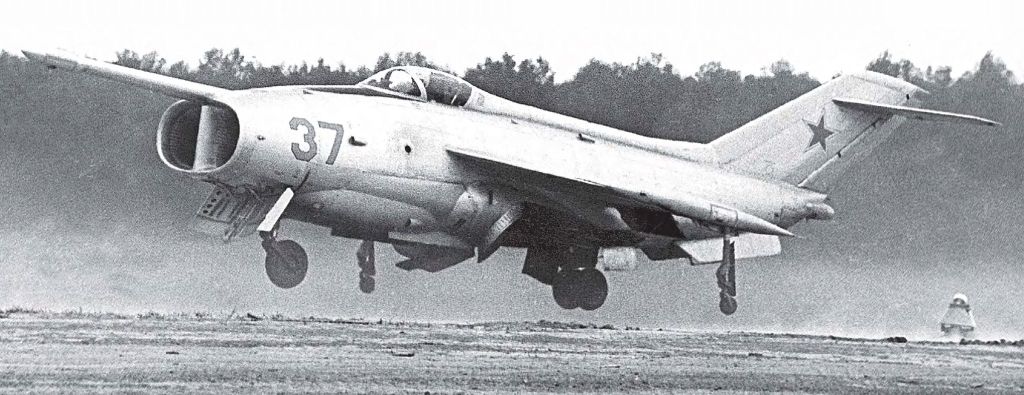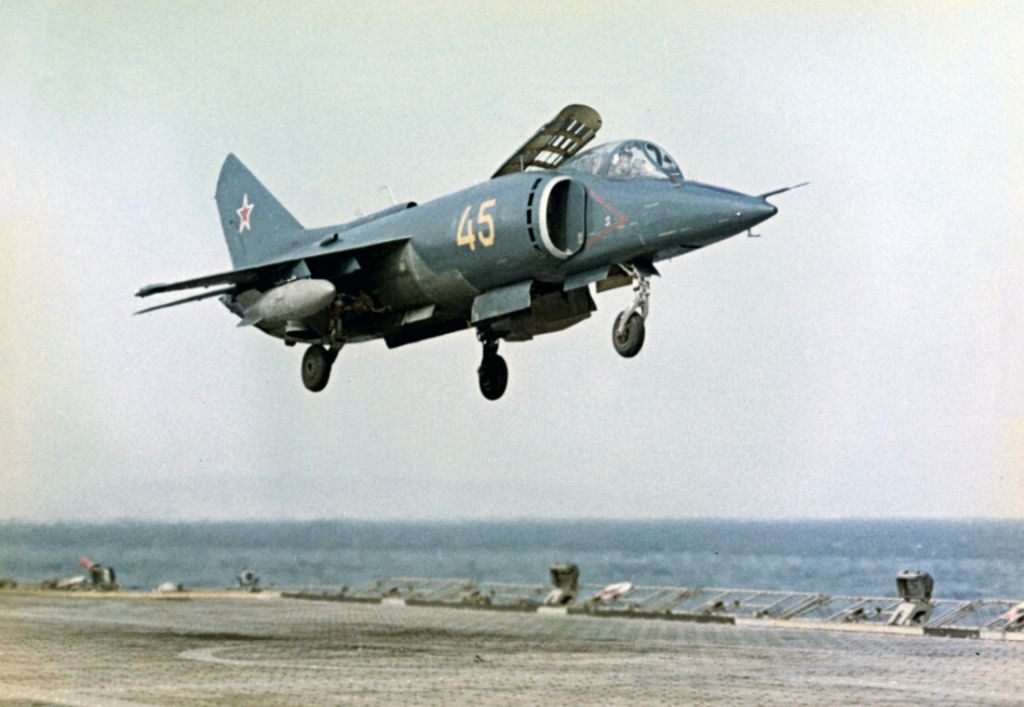Yakovlev seeks to develop next-generation russian vertical take-off and landing fighters
Russian aircraft manufacturer Yakovlev, part of United Aircraft Corporation Rostec, is ready to resume work on creating vertical take-off and landing fighters, and at a new level: the fifth generation.
“Our designers were exploring the prospects of creating even more advanced machines, corresponding to the level of the fifth generation of combat aircraft. The subject of vertical takeoff and landing aircraft was frozen in the difficult 1990s, but we have preserved the scientific and technical fundamentals. Their combination with new aviation technologies makes it possible to resume the development of vertical takeoff and landing aircraft fairly quickly,” said Andrey Boginsky, Deputy Director General for Civil Aviation of the UAC, CEO of Yakovlev PJSC.
The development of Soviet VTOL aircraft by Yakovlev
Yak-36, the first Soviet VTOL
The Yak-36 was a Soviet demonstrator of vertical takeoff and landing (VTOL) technologies, the first flight of which was made on January 9, 1963, and the first “traditional” horizontal takeoff (traversing the runway like a normal aircraft) was 60 years ago, on July 27, 1964, at the controls of test pilot V.G. Mukhin. Just two months later, on September 27, 1964, the aircraft made its first free stationary flight with the transition to horizontal flight. The first full profile flight, with vertical takeoff and landing, took place two years later, on March 24, 1966.
A year later, in July 1967, at the Domodedovo air show, the Yak-36 VTOL aircraft caused a worldwide sensation by demonstrating its vertical takeoff and landing capabilities. A total of four examples were built, on which various design solutions were studied, piloting techniques and operating procedures were developed.
The Yak-36 was equipped with two lift engines and R-27 propulsion, had a take-off weight of 9400 kg and reached a speed of up to 1100 km/h. The flight range was 500 km. The aircraft had rotating nozzles, a thrust control system and automatic flight control. This aircraft never reached operational status, because it was intended for testing and experimentation, but the valuable knowledge gained served to shape the first operational Soviet VTOL fighter aircraft, the Yak-38.
The Yak-38 and its tragic record
The Soviet Navy became interested in the VTOL concept and commissioned the Yakovlev design bureau to develop an embarked fighter that could take off and land vertically from its Kiev-class aviation-capable heavy cruisers. The first full profile flight took place on February 25, 1972. That same year, during testing, the Yak-38 became the first Soviet aircraft to land on a warship, the helicopter-carrying cruiser Moskva.
The Yak-38 was adopted by the USSR Navy and became the first Soviet naval combat aircraft, as well as the second ship-based short take-off and vertical landing aircraft in the world, after the British Harrier. Later, a training version, the Yak-38U, and the modernized Yak-38M, which was equipped with more powerful engines, external fuel tanks and a modified steerable nose landing gear, appeared. Between 1975 and 1988, 236 aircraft were built. The Yak-38 also boasts a dismal safety record, with more than 50% of the fleet lost in accidents.
The supersonic Yak-141
The first flight of the Yak-141 was made on March 9, 1987, the world’s first supersonic VTOL fighter. In this aircraft, test pilot A.A. Sinitsin set 12 world records. A total of four prototypes were created. During its creation, the latest scientific and technical solutions were applied both in the design of the aircraft structure and in the selection of weapons and equipment. The advanced control system of the Yak-141 ensured automation of almost all flight modes, as well as synchronization of engine operation. These innovations greatly simplified the piloting process during takeoff and landing.
Unfortunately, the project did not go into production due to funding cuts in the 1990s as a result of the collapse of the Soviet Union. But it did have a sort of continuity, unsuspected only a few years earlier, in the F-35B Lightining II.
In 1991, Lockheed and Yakovlev signed a cooperation agreement that, among other things, allowed the U.S. company to obtain information on the Yak-141, including test data that required years of development. In 1995, with the permission of the Russian government, OKB Yakovlev sold all the information on the Yak-141 to Lockheed Martin, an investment that allowed the American firm to save a lot of time and resources in the development of the VTOL version of the F-35. The “Soviet heritage” of the F-35B is particularly evident in the design of the rotating nozzle that deflects hot engine exhaust downward, allowing the aircraft to take off and land vertically.
Is a fifth-generation Russian VTOL fighter feasible?
While Andrey Boginsky claims that over the past 60 years the Russian company has accumulated a wealth of experience and expanded its competencies in the development and operation of this type of aircrafts and is ready to bring them to life in a short time, it is nevertheless certain that the latest military aircraft designed by the company are the Yak-130 advanced trainer (developed in partnership with Leonardo) and the Yak-152 primary trainer, but its primary workload is represented by the SJ-100 and the new MC-21 programs, both of which are commercial passenger transport models. So, one might genuinely ask what is the actual know-how of Yakovlev’s technical staff in the area of high-performance military STOVL/VTOL aircraft?
Developing a VTOL fighter is a considerable technical and economic challenge, as Yakovlev engineers are well aware. Increasing this complexity by incorporating the characteristics of a fifth-generation fighter is even more demanding. This difficulty is compounded by the fact that Russia, engaged in a war of attrition in Ukraine and with only one fifth-generation fighter in production (the Su-57), has limited resources for research and development on systems that have no immediate application in the conflict.
Perhaps Boginsky’s statement is not addressed to the Russian Ministry of Defense, but to the Chinese Ministry of Defense. It has been mentioned in the Chinese media for almost 10 years now that the country is working on this development, based on the People’s Liberation Army Navy’s (PLAN) needs for stealth fighter jets with STOVL (short take-off and vertical landing) capability that can operate from its amphibious assault ships or from improvised runways on Pacific islands, such as the Lockheed Martin F-35B.
Latest Video : China’s latest STOVL fighter Jet exposed! Chengdu Aircraft Industrial’s patented design is very advanced. Will be in service on 075/076 LHD ?https://t.co/1UXaBWxqbM pic.twitter.com/uYcqnGvUaZ
— 彩云香江 (@louischeung_hk) May 27, 2023
Time will tell if Yakovlev can revive its legacy of innovation in vertical combat aviation and adapt it to the demands of the 21st century. Cooperation with China could offer a way to overcome these obstacles. Russia’s experience in VTOL aviation, albeit not very up-to-date, combined with China’s resources and ambition, could bring to life an Eastern alternative to the F-35B.

/https://aviacionlinecdn.eleco.com.ar/media/2024/07/Yak-141.jpg)



Para comentar, debés estar registradoPor favor, iniciá sesión